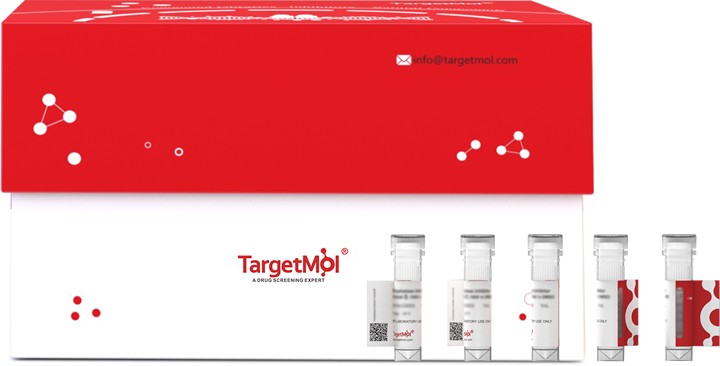- Remove All
 Your shopping cart is currently empty
Your shopping cart is currently empty
DEP-1 Protein, Human, Recombinant (aa 997-1337, His)
DEP1 / PTPRJ (Receptor-type tyrosine-protein phosphatase eta) is a member of the protein tyrosine phosphatase (PTP) family. PTPs are known to be signaling molecules that regulate a variety of cellular processes, including cell growth, differentiation, mitotic cycle, and oncogenic transformation. DEP1 / PTPRJ possesses an extracellular region containing five fibronectin type III repeats, a single transmembrane region, and a single intracytoplasmic catalytic domain, and thus represents a receptor-type PTP. DEP1 / PTPRJ is present in all hematopoietic lineages, and was shown to negatively regulate T cell receptor signaling possibly through interfering with the phosphorylation of Phospholipase C Gamma 1 and Linker for Activation of T Cells. This protein can also dephosphorylate the PDGF beta receptor, and may be involved in UV-induced signal transduction. In stable MCF-7 cell lines, induction of DEP-1 expression inhibited breast cancer cell growth by 5-10-fold. These data describe PTPs expressed and regulated in breast cancer cell lines during differentiation and identify one PTP, DEP-1, that inhibits the growth of breast cancer cells in vitro.

DEP-1 Protein, Human, Recombinant (aa 997-1337, His)
| Pack Size | Price | Availability | Quantity |
|---|---|---|---|
| 5 μg | $87 | 7-10 days | |
| 10 μg | $139 | 7-10 days | |
| 20 μg | $232 | 7-10 days | |
| 50 μg | $458 | 7-10 days | |
| 100 μg | $798 | 7-10 days | |
| 200 μg | $1,390 | 7-10 days | |
| 500 μg | $2,930 | 7-10 days |
Product Information
| Biological Activity | Activity testing is in progress. It is theoretically active, but we cannot guarantee it. If you require protein activity, we recommend choosing the eukaryotic expression version first. |
| Description | DEP1 / PTPRJ (Receptor-type tyrosine-protein phosphatase eta) is a member of the protein tyrosine phosphatase (PTP) family. PTPs are known to be signaling molecules that regulate a variety of cellular processes, including cell growth, differentiation, mitotic cycle, and oncogenic transformation. DEP1 / PTPRJ possesses an extracellular region containing five fibronectin type III repeats, a single transmembrane region, and a single intracytoplasmic catalytic domain, and thus represents a receptor-type PTP. DEP1 / PTPRJ is present in all hematopoietic lineages, and was shown to negatively regulate T cell receptor signaling possibly through interfering with the phosphorylation of Phospholipase C Gamma 1 and Linker for Activation of T Cells. This protein can also dephosphorylate the PDGF beta receptor, and may be involved in UV-induced signal transduction. In stable MCF-7 cell lines, induction of DEP-1 expression inhibited breast cancer cell growth by 5-10-fold. These data describe PTPs expressed and regulated in breast cancer cell lines during differentiation and identify one PTP, DEP-1, that inhibits the growth of breast cancer cells in vitro. |
| Species | Human |
| Expression System | E. coli |
| Tag | N-His |
| Accession Number | Q12913 |
| Synonyms | SCC1,R-PTP-ETA,protein tyrosine phosphatase, receptor type, J,HPTPeta,DEP1,CD148 |
| Construction | A DNA sequence encoding the human PTPRJ (Q12913) cytoplasmic domain (Arg 997-Ala 1337) was expressed, with a polyhistide tag at the N-terminus. Predicted N terminal: Met |
| Protein Purity | > 95 % as determined by SDS-PAGE |
| Molecular Weight | 41kDa (predicted); 37 kDa (reducing conditions) |
| Endotoxin | Please contact us for more information. |
| Formulation | Lyophilized from a solution filtered through a 0.22 μm filter, containing PBS, pH 7.5. Typically, a mixture containing 5% to 8% trehalose, mannitol, and 0.01% Tween 80 is incorporated as a protective agent before lyophilization. |
| Reconstitution | A Certificate of Analysis (CoA) containing reconstitution instructions is included with the products. Please refer to the CoA for detailed information. |
| Stability & Storage | It is recommended to store recombinant proteins at -20°C to -80°C for future use. Lyophilized powders can be stably stored for over 12 months, while liquid products can be stored for 6-12 months at -80°C. For reconstituted protein solutions, the solution can be stored at -20°C to -80°C for at least 3 months. Please avoid multiple freeze-thaw cycles and store products in aliquots. |
| Shipping | In general, Lyophilized powders are shipping with blue ice. |
| Research Background | DEP1 / PTPRJ (Receptor-type tyrosine-protein phosphatase eta) is a member of the protein tyrosine phosphatase (PTP) family. PTPs are known to be signaling molecules that regulate a variety of cellular processes, including cell growth, differentiation, mitotic cycle, and oncogenic transformation. DEP1 / PTPRJ possesses an extracellular region containing five fibronectin type III repeats, a single transmembrane region, and a single intracytoplasmic catalytic domain, and thus represents a receptor-type PTP. DEP1 / PTPRJ is present in all hematopoietic lineages, and was shown to negatively regulate T cell receptor signaling possibly through interfering with the phosphorylation of Phospholipase C Gamma 1 and Linker for Activation of T Cells. This protein can also dephosphorylate the PDGF beta receptor, and may be involved in UV-induced signal transduction. In stable MCF-7 cell lines, induction of DEP-1 expression inhibited breast cancer cell growth by 5-10-fold. These data describe PTPs expressed and regulated in breast cancer cell lines during differentiation and identify one PTP, DEP-1, that inhibits the growth of breast cancer cells in vitro. |
Dose Conversion
Sci Citations
Calculator
Tech Support

Copyright © 2015-2025 TargetMol Chemicals Inc. All Rights Reserved.


